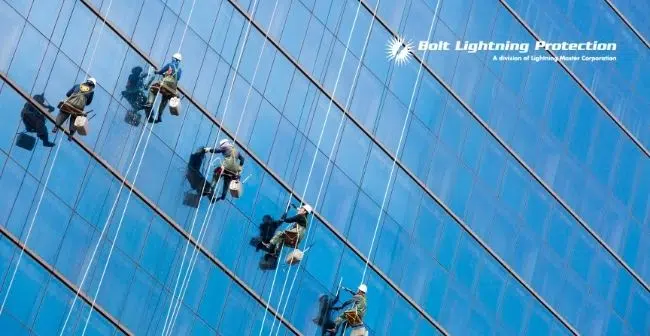Risk of Lightning Damage to Commercial Facilities
Lightning strikes are far more common than people realize. Lightning strikes occur about 100 times every second, and the United States experiences about 23 million cloud-to-ground strikes each year. If not planned for, these strikes can cause extensive damage to commercial and industrial facilities.
For many corporations, the effects of one direct lightning strike can cause an operation to experience loss of production due to physical, secondary, or EMP damage According to Underwriters Laboratories, business losses related to lightning can run into the billions of dollars once you factor in unplanned downtime, operational breakdowns, and the significant damage and destruction of assets, equipment, and facilities.
Lightning is unpredictable and damaging. Due to its non-selective nature, lightning risks affect all areas. For this reason, it’s important to invest in a lightning protection system.
Effective lightning protection systems don’t just consist of air terminals, conductors and grounding rods to dissipate lightning current to the Earth. They also consist of surge protection devices and proper bonding and grounding.
How Does Lightning Damage Commercial Facilities?
Fires
A bolt of lightning packs up to 100 million volts of electricity. That’s enough power to heat the surrounding air. Lightning cuts across to 50,000 degrees Fahrenheit. Lightning strikes can result in fires in volatile environments.
Potential structure damage
You’re not safe either if your facility is made of steel and concrete. Concrete never quite dries out as there’s always latent moisture in the material. When exposed to the high temperatures associated with lightning strikes, this moisture turns to steam, expands, and damages the structure.
The shock waves produced by lightning strikes can also fracture concrete and damage equipment. Lightning is also capable of sending electricity through electrical wires and metal reinforcements in concrete structures.
Equipment Damage
Electronics, appliances, and technology are often times the casualties of lightning strikes.
Electromagnetic pulses (EMP) that can result from lightning strikes are comparable to that of a high-altitude nuclear blast. Anything electronic or powered by electricity can be damaged by EMP. A large enough EMP could knock out power or damage electronic equipment.
Damage to electrical equipment can be devastating to organizations. Not only will the equipment need to be replaced, which can be costly, but it can also bring business operations and production to a halt, with the risk of data loss.
Lightning Related Failures Can be Prevented
Since lightning is an act of God, not all lightning related incidents can be prevented. However, there are measures that can be implemented to mitigate lightning damage. Bolt Lightning Protection has developed an integrated approach to lightning protection.
Our three-pronged approach is designed to protect your property from both direct and indirect lightning strikes, which includes:
Going forward, changing weather patterns will further exacerbate the risk of lightning damage. As such, commercial and industrial property owners can expect to face even greater risks at facilities in which downtime is a costly luxury.
Some facilities are more at risk than others due to their location, the construction of the building, and whether there are any installed lightning protection solutions.
Bolt Lightning Protection is a division of Lightning Master and provides comprehensive lightning protection, site surveys, risk assessments, and inspections. All of our lightning protection systems are designed to meet industry standard – NFPA 780/UL96/96A.
Feel free to contact Bolt Lightning Protection for a consultation, site survey, or inspection of your facility. Are you properly protected?


